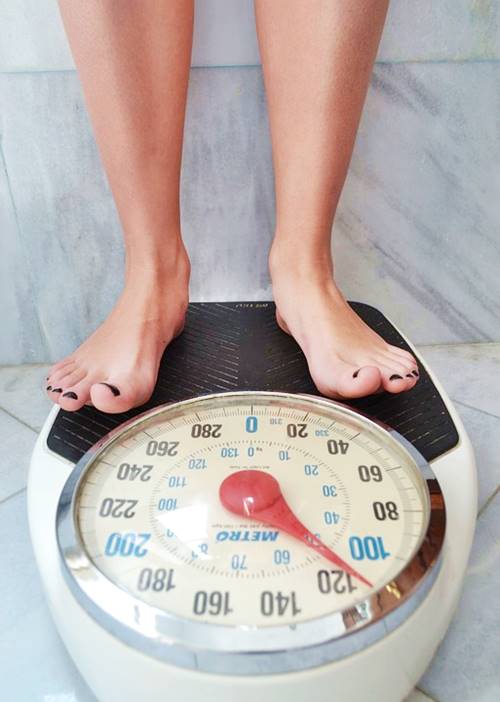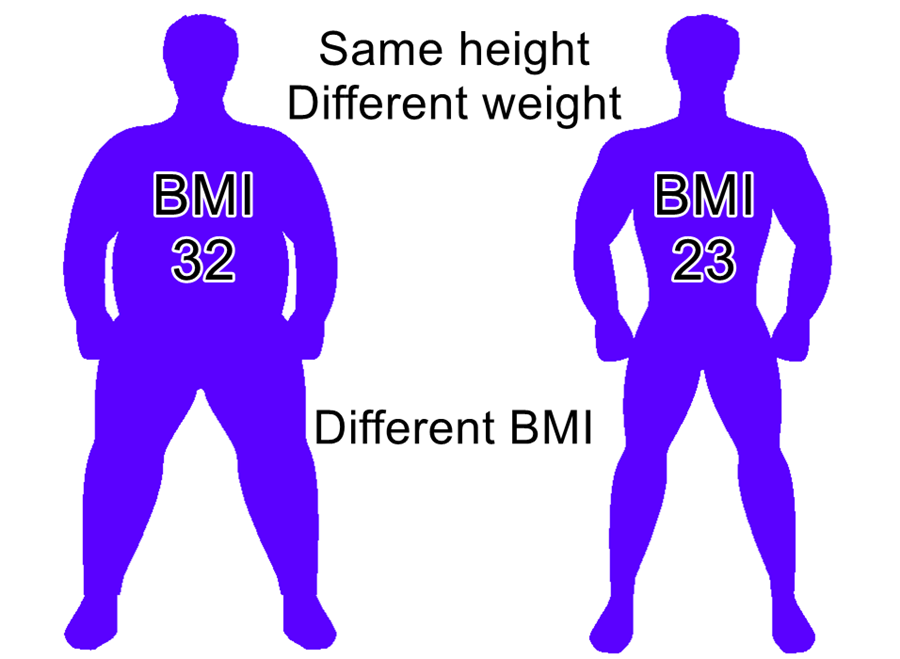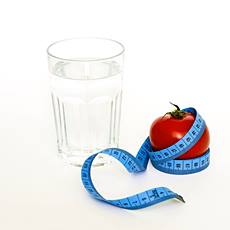Body Mass Index Calculator
Learn about BMI
All you need to know about Body Mass Index or BMI
In this article we will show you our Body Mass Index or BMI calculator, and provide a summary on:
We will also mention its shortcomings and some alternative methods for assessing body fatness.

Photo: Maxpixel
What is BMI?
Before going on to calculate your BMI, let's first explain what it is.
BMI is the relationship between a person's height and weight. That is why it is an "index". And although it does not measure your body fat directly, it provides a very good idea of a person's weight range (that is, if you are obese, overweight, normal, or underweight).
It is widely used because it is an easy and inexpensive way to define a person's body fat.
BMI calculation
The formula uses the metric system and is the following:
BMI = Weight (kg) ⁄ (height (m))2
So it is the weight of a person in kilograms divided by the height in meters squared.
Example
A person weighing 80 kg and measuring 1,80 m will have the following BMI:
BMI = 80 ⁄ (1,80)2 = 22.2
Pounds and Inches
The same formula is used with pounds and inches but converting pounds to kilograms and feet and inches to meters. This results in:
BMI = 703 x Weight (lb) ⁄ (height (in))2
Another Example
A person weighing 170 lb and measuring 6' 2 will have the following BMI: (remember to convert feet to inches - 6' 1 is 73 inches )
BMI = 703 x (170 ⁄ 732) = 22.4
Our BMI Calculator
This calculator provides the Body Mass Index (BMI) and the corresponding BMI weight status category.
Use this calculator for adults 20 years old and older. This calculator shouldn't be used for pregnant women or children.
The Outcome of your BMI Calculation
Using your BMI to gauge your weight situation
The BMI number that you calculated will help you know which is your weight classification, as a first step to tackle issues of over or undereating.
For your reference the BMI ranges and their classification based on the World Health Organization guidelines (1), are the following:
Classification
Score
Underweight
BMI of less than 18.5
Normal weight
BMI is 18.5 to 24.9
Overweight
BMI is 25 to 29.9
Obese
BMI is 30 or more
Risk factors for Overweight or Obese people
Those with a BMI above 25 are either overweight or obese and have a higher risk of suffering from chronic conditions such as (2):
- Type 2 diabetes
- High cholesterol
- High blood pressure
So if your BMI is higher than 25 you should seriously consider losing weight, even if it is a small loss it will help you lower the risk of disease.
BMI shortcomings
The objections to BMI arise from the fact that it is only a rough estimation because it does not consider the age, gender, or ethnicity of the person. It also ignores the "body build".
Examples of the influence of age, gender, and ethnicity on BMI:
- Women have more body fat than men with the same BMI
- Blacks have less body fat than Whites (with the same BMI) (3).
- At the same BMI, Asians have more body Fat than Whites (4).
- Older people have more body fat than young adults with the same BMI

A. Whittall
Examples
For instance, two persons with the same height and weight, and therefore the same BMI could appear as "overweight", but if one ("A") is fit and has plenty of muscle mass while the other ("B") is out of shape and packs most of his or her weight as fat, it is clear that even though both have the same BMI, "A" is fitter than "B".
Furthermore, muscle weighs more than the same volume of fat because it is denser: the density of fat is 0.9 g/cm3 (1.517 lb/yd3) while the density of fat-free-mass - or muscle is 1.1 g/cm3 (1854 lb/yd3) (5).
This means that "A" who is more muscular will appear slimmer because his muscle occupies less space than the same weight of fat. So "B" who has more fat in his body will be more stodgy or heavily built.
That is why health specialists recommend that you also Check Your Waist Measurement besides calculating your BMI.
Waist Circumference
Measuring your waistline is a simple thing to do and it will quickly show you if you are carrying excess body fat around your middle.
Maximum Waist Circumference
These are the maximum allowed values recommended by the American Heart Association, National Heart, Lung, and Blood Institute (6):
Gender
Maximum Waistline
Women
less than 35 inches - 88 cm
Men
less than 40 inches - 102 cm
Your waist size matters because health risk is not only about "how much fat" you carry around with you, but where your fat stores are located:
Fat stored in your hips or thighs is less risky than the fat stored in your middle: abdominal fat is an indicator of higher health risk. This was shown in a study conducted in 2013 (7) that concluded that:
Visceral adiposity is associated with incident cardiovascular disease and cancer after adjustment for clinical risk factors and generalized adiposity. These findings support the growing appreciation of a pathogenic role of ectopic fat. Britton et al. 1961
Ectopic fat is fat that is stored in tissues other than adipose tissue (the normal fatty tissue). This fat is stored in tissue that normally contains only small amounts of fat, such as the liver, skeletal muscles, heart, and pancreas.
Visceral adiposity is body fat that is stored within the abdominal cavity, around important internal organs such as the liver, pancreas. and intestines.
The article tells us that abdominal fat increases the risk of cancer and heart disease.
We discuss the Waist size and the Waist-to-Hip Ratio in our "Waist Size Matters" webpage:
Read More:
Waist circumference is a good indicator of fat stored in your midsection and will give you a clear picture of the health risks involved.
Other Ways of measuring body fatness
There are other methods for measuring body fat such as the skinfold thickness measurements, where the fat stored under your skin is measured with calipers.
Other methods include underwater weighing, bioelectrical impedance, etc. These methods are expensive, require special equipment, and trained personnel.
Health risks associated with obesity
People who are overweight or obese are at an increased risk for several health conditions such as:
- High blood pressure (Hypertension).
- Type 2 diabetes.
- Chronic Inflammation (8, 9).
- Stroke and Coronary heart disease
- Cancers associated with overweight and obesity make up 40% of cancers diagnosed in the US.
- Overweight and obesity are associated with at least 13 types of cancer. (10).
- Sleep apnea
- Life quality (11).
- Mental illness: depression and anxiety.
- Joint pain.
Our page on the "Dangers of Abdominal Fat" explains the health risks associated with a fat midsection:
Read More:
Visceral fat is associated with diabetes, dementia, asthma, several types of cancer, and heart disease.

References and Further Reading
(1) Body mass index - BMI. World Health Organization. Retrieved 08.28.2018
(2) Grundy SM, Cleeman JI, Daniels SR, et al. Diagnosis and management of the metabolic syndrome: an American Heart Association/National Heart, Lung, and Blood Institute Scientific Statement. Circulation. 2005;112:2735-52
(3) The Endocrine Society. Widely Used Body Fat Measurements Overestimate Fatness In African-Americans, Study Finds. ScienceDaily. ScienceDaily, 22 June 2009
(4) Deurenberg-Yap M, Schmidt G, van Staveren WA, Deurenberg P. The paradox of low body mass index and high body fat percentage among Chinese, Malays and Indians in Singapore. Int J Obes Relat Metab Disord. 2000 Aug;24(8):1011-7
(5) Siri WE. Body composition from fluid spaces and density: Analysis of methods. In: Brozek J, Henschel A, editors. Techniques for Measuring Body Composition. National Academy of Sciences/National Research Council; Washington, DC: 1961. pp. 223-44
(6) US Department of Health and Human Services, Public Health Service, National Institutes of Health, National Heart, Lung, and Blood Institute. The Evidence Report. Bethesda, MD: 1998. Clinical Guidelines on the Identification, Evaluation, and Treatment of Overweight and Obesity in Adults
(7) Britton KA, Massaro JM, Murabito JM, Kreger BE, Hoffmann U, Fox CS. (1961) Body Fat Distribution, Incident Cardiovascular Disease, Cancer, and All-cause Mortality. Journal of the American College of Cardiology, v. 62, no. 10, 921-925. DOI: 10.1016/j.jacc.2013.06.027
(8) Engstrom G, Hedblad B, Stavenow L, Lind P, Janzon L and Lingarde F. Inflammation - sensitive plasma proteins are associated with future weight gain. Diabetes. Aug 2003; 52(08): 2097-101
(9) Marseglia L, Manti S, D'Angelo G, Nicotera A, Parisi E, DiRosa G, Gitto E, Arrigo T. Oxidative stress in obesity: a critical component in human diseases. International Journal of Molecular Sciences. Dec 2014; 16(1):378-400
(10) Obesity and Cancer. October 3, 2017. Centers for Disease Control and Prevention
(11) Han, T. S., et al. Quality of life in relation to overweight and body fat distribution. American Journal of Public Health 88.12 (1998): 1814-1820
About this Article
BMI Calculator, A. Whittall
©2018 Fit-and-Well.com, 11 Oct. 2018. Updated. 10 Nov. 2020. https://www.fit-and-well.com/resources/bmi-calculator.html
Tags: Body Mass Index, BMI, BMI Calculator, Obesity, Waist Size.
This Webpage
Subject: Fit-and-Well.com. Body Mass Index (BMI) Calculator. What is it, and how is it calculated? Some pros and cons. Its implication on weight management and your health.






